
Voyage of Mercy
Merchant mariners rescue 14,000 Korean refugees facing death
Rosanne Fohn
Reprinted from USAA Magazine, November/December 2002,
USAA, San Antonio, TX © 2002.
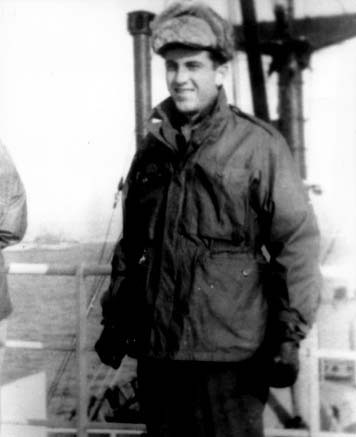 |
Staff Officer Bob Lunney on the deck of the SS Meredith
Victory |
In all, about 98,000 came to the docks--desperate, waiting, and hoping for their only salvation from an almost certain death--evacuation by sea. Peering through binoculars from the deck of the small merchant marine freighter, the SS Meredith Victory, Staff Officer Bob Lunney observed the masses of North Korean refugees lining the snow-covered piers and beach of Hungnam Harbor.
Their clothes were dirty, ragged and torn from days of plodding through the frozen countryside to Hungnam, located about 138 miles north of the 38th parallel--the official boundary between North and South Korea.
Considered to be anti-Communist sympathizers, the refugees were fleeing North Korean and Chinese troops, who were inflicting heavy casualties on the U.N. troops, including many Americans.
After a massive retreat, most of the U.N. troops had been evacuated through Hungnam when the Meredith Victory arrived on Dec. 22, 1950. Only the Army's 3rd Infantry Division and the ships and carriers from the 7th Fleet were holding the enemy troops at bay.
Aboard ship, Lunney, then 23, watched as a small boat pulled up and several U.S. Army colonels came aboard to speak to Capt. Leonard LaRue, the ship's master. They asked LaRue to discuss with his officers whether they should help evacuate the refugees. It was a particularly dangerous mission, considering that the ship's lower hold carried 300 tons of aviation fuel in metal drums and Hungnam Harbor was one of the most heavily mined in Korea.
"Without conferring with anyone, the captain said, 'I will agree to take my ship in and take out as many people as I can,'" recalls Lunney. With that, the Meredith Victory's new course was set. It became one of about 150 ships to participate in the rescue of troops and civilians from Hungnam, but had the distinction of being the last refugee ship out of the harbor.

|
The SS Meredith Victory usually ferried
such supplies as tanks, trucks, ammunition, and troops during the Korean War. In December 1950
it carried 14,000 North Korean refugees to freedom. |
As a freighter, the Meredith Victory was an unarmed vessel about 450 feet long and 50 feet wide, with five cargo holds, each with three decks. Its job was to ferry supplies, such as tanks, trucks, ammunition, fuel, and troops. But today, as the ship entered the Hungnam's inner harbor, the minesweepers pulled farther and farther away. "They wanted nothing to do with our jet fuel," Lunney says.
A sea of humanity
 |
North Korean refugees stand shoulder to shoulder on the deck and
fill five cargo holds. |
"The port was in chaos. The beach was just a sea of humanity," Lunney recalls. "The Navy pilots were constantly attacking the Chinese with napalm bombs in support of the 3rd Infantry Division, which was holding the line. I recall this huge glow of fire on the perimeter of the city. The 1st Marine Division, the Army's 7th Infantry Division, and the Republic of Korea's I Corps had already been evacuated, and most of the artillery had been loaded onto the ships. The only heavy fire support we had at that time was from the Navy," he explains. American warships were shelling the coastline and there was some concern that "friendly fire" could cause a massive explosion.
"We had the ship turned around facing the sea-- something you usually don't do--and we kept the steam on the engines, ready to leave port at a moments notice," says Merl Smith, a licensed junior engineer and Navy reservist also serving aboard the Meredith Victory.
The Army Corps of Engineers quickly built a wooden causeway from the beach to the Meredith Victory so the refugees could board. Evacuees were lowered like cargo into the holds on wooden pallets and stood shoulder to shoulder alongside the fuel drums on the ship's lowest level. As each compartment was filled, the hatch boards were put in place.
After the lower holds were full, the refugees spilled out onto the main deck. "There they were exposed to the harsh winter elements, including the frigid ocean spray." Smith recalls. Twenty-six hours later, shortly past 11 a.m. on Dec. 23, the ship was full. Amazingly, the small freighter had taken on 14,000 refugees.
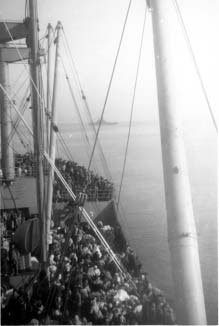 |
The refugees braved freezing temperatures on deck during their
two-day voyage. |
Cargo of souls
In an article for "This Week" magazine, dated Dec. 11, 1960, the now deceased Capt. LaRue said, "I cannot possibly describe the nightmarish quality of that journey. We had no food and almost no water for the refugees--they ate only what they could bring aboard. There were no extra blankets, no clothing to warm them." There were no sanitary facilities, no doctor or medical supplies and no interpreter.
"With this cargo of souls, we steamed out to the open sea toward Pusan on the southeast Korean coast. about 450 sea miles, or about 28 hours' journey," LaRue continued. "Ahead lay these formidable risks: We were facing waters mined by the enemy with a vessel that had no means of detecting them or destroying them. We knew that Communist submarines, operating in the vicinity, could easily spot us and sink us with a torpedo. A spark could turn the ship into a funeral pyre. We had no escort vessels and no way to protect ourselves against air raids. Yet nothing touched us during that incredible voyage toward Pusan.
Lunney remembers one especially harrowing incident along the way. "The captain asked me to go down below because a number of the passengers were building fires atop the fuel drums to keep warm and to heat food" he says. After waving his arms, yelling the word "No!" and simulating an explosion with his voice and hands, the staff officer was able to get the refugees to put out their fires. Even so, there was a spark of hope-- several babies were born during the voyage.
Christmas Eve
When the ship finally arrived at Pusan on Christmas Eve, it was turned away because the city was overrun with evacuees and the retreating military. The crew was astounded to learn that only a few refugees who had come aboard wounded, plus a few people identified as Communist sympathizers, would be taken off the ship. "I thought maybe some of the refugees would start jumping overboard, but they didn't," Smith recalls.
Authorities ordered the ship to sail instead to Koje-Do, an island about 50 miles to the southwest. To calm the refugees, LaRue convinced authorities to send some South Korean military police and interpreters onboard for the rest of the journey. He also requested food and water, but there was only enough for a few refugees on the deck.
The ship arrived at Koje-Do later on Christmas Eve, but it lingered overnight on the open sea while the logistical problems of unloading were resolved. The harbor was already overcrowded. They would have to use several Landing Ship Tanks (LSTs)-- Navy vessels used to land tanks on a beach--to get the refugees from ship to shore.
Land at last
On Christmas Day, 1950, which also happened to be Smith's 23rd birthday, the crew finally was able to unload its human cargo. LSTs were lashed to the Meredith Victory and a winch and pallet lowered the refugees, 16 at a time, into them. "The risk of death or serious injury was great," LaRue was quoted as saying in "This Week" magazine. "The vessels pitched perilously in the swelling sea all through the unloading, the hulls banging and separating. The lines might part; somebody could be crushed between the two ships." Yet no one was.
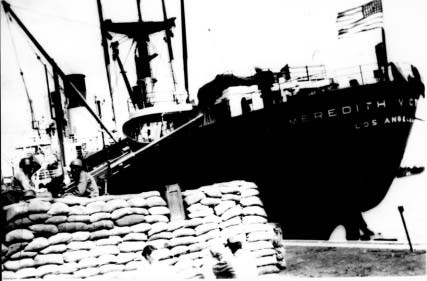
|
SS Meredith Victory |
As they left, the Koreans gave a halfbow. "There was no overwhelming joy on their faces because they had only begun their journey to freedom," Lunney says.
Smith says, "I can still see their faces, especially the kids. That touches me more than anything, the little kids. I can see them holding on to their parents and they haven't any idea what's going on."
The voyage had a profound effect on LaRue. He left the sea and in 1954 became a Benedictine monk, taking the name Brother Marinus, a reference to the Virgin Mary. He lived in St. Paul's Abbey in Newton, New Jersey until his death in October 2001.
We meet again
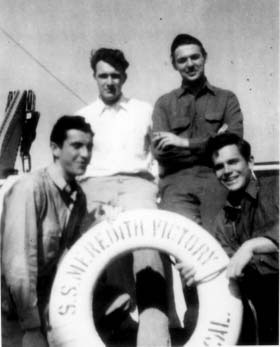
|
Merchant Marine shipmates Bob Lunney, Merl Smith, Al
Kaufhold and Burley Smith on board the SS Meredith Victory |
In June of this year, Lunney had the opportunity to meet a mother and son who were passengers on the Meredith Victory 52 years ago. The mother, a Mrs. Kang, had carried her three children onto the ship. The youngest was 9-month old Anton Kang, who was strapped to her back. Kang is now a Benedictine priest.
Lunney says Mrs. Kang recalled the thunderous roar of the 16-inch shells from the Navy ships holding off the enemy. Kang was grateful for the opportunity to escape, he says.
While in South Korea, Lunney received the Korean Order of Military Merit Ulchi with Gold Star from the Korean War Veterans Association.
Bob Lunney
A Naval reservist who sailed with the Merchant Marine to pay his way through college and Cornell Law School, Lunney went on to practice law while continuing a nearly 43-year career in the Naval Reserve. He retired from the Navy as a captain in 1987, but continues to practice law in White Plains, New York. He was asked by the U.S. Department of Defense in 1997 and 1998 to observe joint recovery operations and confer with the North Korean Ministry of Foreign Affairs regarding prisoners of war and American servicemen missing in action.
Merl Smith
Upon graduating from the U.S. Merchant Marine Academy, Smith's first ship was the SS Meredith Victory. He sailed for several years on merchant ships as an engineering officer, then went on active duty with the Navy aboard the carrier USS Boxer. He later left the military as a lieutenant for a career as a sales marketing manager. Now, 74, Smith lives in Valatie, New York.
Saluting the Crew
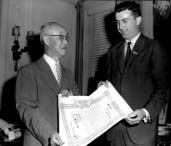
|
Bob Lunney accepts the Korean Presidential Unit
Citation June 3, 1958, from Korean Consul General D.Y. Namkoong on behalf of the SS Meredith
Victory's officers and crew. |
Though its contributions were overshadowed during the Korean War, the SS Meredith Victory and its crew were recognized nearly a decade later:
- In 1958 South Korean President Syngman Rhee awarded the officers and crew the Korean Presidential Citation.
- In 1960 the United States government, by special act of Congress, decorated the officers and crew with the Gallant Ship Unit Citation Bar, the only merchant marine ship and crew serving during the Korean War to receive such an honor. Capt. Leonard LaRue also was presented the Merchant Marine Meritorious Service Medal.
- According to retired Navy Capt. Bob Lunney's citation letter from the U.S. Department of Commerce Maritime Administration, dated April 29, 1960, "The courage, resourcefulness, sound seamanship and teamwork of her master, officers, and crew in successfully completing one of the greatest marine rescues in the history of the world have caused the name of the Meredith Victory to be perpetuated as that of a Gallant Ship."
Page last modified: